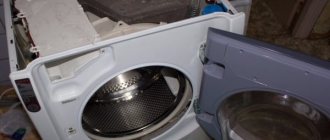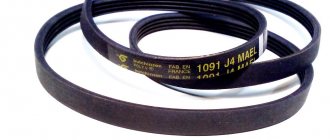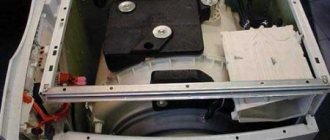How to replace the belt on a Samsung washing machine
Washing machines manufactured by Samsung have a cover located at the back that is not removable. This always makes it very difficult to eliminate unit breakdowns.
To fix the problem, you will need:
- The same belt - should be selected with markings identical to the failed one;
- A piece of electrical tape no more than 15 centimeters long;
- Half a meter of wire 0.5-0.8 millimeters thick;
- Wire cutters;
- A flashlight or any other device that can become a light source;
- Crosshead screwdriver.
Before starting repairs, inspect the gear and drum pulley. The gear has several compartments for the belt mates. It is installed from top to bottom. When installing a new belt in place of the old one, it is important to correctly get to where the failed element was previously. If it gets too close to the gear, it will not be clear how correctly it is installed. There is a possibility that in this case part of the belt will either sag or stand on the edge of the pulley and then the repair work will have to be repeated.
After the strap is put on the gear, it needs to be moved slightly to the side. It is important to choose a pulley position where it has support from turning the equipment, which, as a rule, constantly tries to move to the opposite side, on which it will stop thanks to the stop.
Use electrical tape to secure the strap. To protect it from damage, a wire is useful - place it on top of the electrical tape, forming about 10 turns and secure its edges by twisting them together. Rotate the pulley until the belt fits properly.
If the actions were performed correctly, you will hear a kind of click. You won't be able to turn the strap because it is securely fixed with the lock you made.
Now you should turn the gear in the opposite direction, and then remove the electrical tape and wire. The renovation is complete.
All actions, in general, take no more than a quarter of an hour, but only when they are performed strictly in accordance with the instructions. To check the result, rotate the pulley. The belt snaps into place and is aligned.
How to change the belt on an Indesit washing machine
First, get a new strap. It is better if it comes from the manufacturer of the washing machine or a trusted seller. First remove the remnants of the failed belt from the machine and only then proceed to install a new one. The replacement belt purchased should be placed on the engine, pressing its upper part more tightly to the pulley. Now you need to simultaneously rotate the drum and install the element on the pulley.
The belt must be in the center of the pulley located on top. This can be achieved by moving it a couple of tracks on the pulley, which is located at the bottom of the equipment.
How to put a belt on an LG washing machine
To replace the strap on LG equipment, unscrew the bolts located on the rear wall of the case and remove the cover secured by them. You can perform these manipulations using a Phillips screwdriver.
Remove the failed strap by pulling it to the side and turning the pulley in parallel. When rotating, the element may burst and fly apart. In this case, it is important to collect all its parts so that they do not damage the machine in the future.
Now we put a new belt on the engine, and after that on the pulley. To do this, pull the strap onto its circle and carefully turn it. Check that the belt is placed exactly where it should be and is firmly pressed into the groove. Rotate the pulley to ensure proper installation. After checking, put back the fixing panel and screw in the bolts.
As you can see, changing a faulty belt in a washing machine is not difficult. The main thing is to carry out all actions slowly and strictly adhere to the drawn up action plan.
Instructions for performing work
To put on a drive belt that has simply fallen off, or to install a new one to replace a broken one, you need to carry out a simple algorithm of actions. Step-by-step instructions for performing the work will be as follows.
- Disconnect the machine from the power supply.
- Close the valve that regulates the water intake into the tank.
- Drain the remaining water, to do this, take a container of suitable volume, unscrew the intake hose from the body, pour the liquid from it into the prepared container.
- Remove the back cover of the washing machine body by unscrewing the fastening bolts located around its perimeter.
- Inspect the drive belt, wires and sensors located near it for any damage.
When the reason for the failure of the automatic machine has been determined, proceed to its elimination. If the belt is intact and has simply fallen off, tighten it back. If it is torn, install a new one.
Put the belt in place as follows: carefully pull the element onto the electric motor shaft, then onto the drum pulley. When performing these manipulations, it is necessary to tighten the belt with one hand and slightly turn the pulley with the other. Please note that the drive belt must be located directly in a special groove.
After the faulty part has been replaced, it is necessary to screw the back cover of the unit housing into place. Don’t forget to secure it with the bolts you removed at the beginning of the work. Next, the washing machine is connected to utilities and connected to the network.
You can fix a breakdown caused by a faulty belt on an Indesit machine with your own hands, without turning to a repairman for help. However, keep in mind that there are some very tight drive elements, and you may need the help of a family member to tighten them.
Interesting:
- Changing the belt on an Ariston washing machine
- How to put a belt on a washing machine
- Belt spins in washing machine
- How to tighten the belt on a Bosch washing machine?
- Error codes for AEG washing machines
- Malfunctions of Hotpoint Ariston washing machines
Reader comments
- Share your opinion - leave a comment
What kind of belts can there be in a washing machine?
V-belt
Most often, such belts are used for asynchronous motors. They are made from high quality material and special strength.
This element, installed in the machine, must be tensioned so that its deflection does not exceed 5 millimeters when pressed with a finger. The tension is produced by moving the motor, with the fasteners pre-unscrewed. If the engine movement is not sufficient to create the required tension, then such an element must be replaced. Its installation is carried out starting with the motor pulley. Next, the strap is inserted into the groove of the drum pulley. Then, holding it in it, they turn the pulley until it is completely in the desired place. Once the strap is in the right place, its installation can be considered complete.
V-ribbed belt
Used for placement in commutator motors. It has a jagged shape. It can have a variety of characteristics regarding its size and shape, as well as have a different number of wedges.
Replacing a post-wedge strap is completely identical to changing a wedge strap. There is only one difference in installation - the poly-V-element should be located in the center of the counter pulley, both on the drum of the washing machine and on the engine.
The tension level of this belt is slightly lower than that of the previous model. It is produced by turning it completely. If the belt tension during repair is too strong, you should be extremely careful not to injure your hands.
Do-it-yourself replacement of the washing machine drive belt
Replacing the washer drive belt is not the most terrible task. It may seem or sound worse.
Washing machines with an asynchronous motor are equipped with V-belts, on the outside of which their number and brand are indicated. The cross-section of the belt is similar to a trapezoid.
V-belts are made from chlorine-resistant materials with high strength (rubber, polyester, cotton materials).
To change the belt yourself, you first need to unscrew the bolts that secure the cover of the rear part of the washing machine body (with an ordinary screwdriver). Removing the cover, we will see the pulley on which the old belt is fixed. By turning the pulley, we remove the wear by pulling it towards you.
The new V-belt must be recessed into the recesses of the pulley and, gradually turning it, press the belt until it is completely seated.
Poly V-belts are used in washing machines with commutator motors. In cross-section, such a belt has a toothed shape formed by rows of wedges. Its markings are indicated on the outside of the belt. Installing a poly V-belt is no different from installing a V-belt. The only thing is that you need to additionally check that the tension is a little weaker and the belt itself lies strictly in the center of the groove of the engine pulley and drum. The pulley should be rotated 360 degrees around its axis, carefully, without overdoing it. When replacing the belt on tight-fitting models, be careful to avoid minor injuries to the limbs.
Belts of narrow washing machines wear out much faster than their “relatives” due to the tight packaging of all components of the product. There is an increase in friction between parts and assemblies against each other. Over time, the belt stretches and begins to rub against the back wall of the machine, thereby wearing out even more. The same applies to other details that become loose after a certain period.
Causes of belt problems
Wear
Characteristic of compact models of washing machines, in which the parts are located extremely close to each other. While the unit is operating, they can rub against each other, thereby wearing out much faster than they should.
Cracked drum pulley
There can be many reasons for the formation of a crack, from overloading the machine to incorrect belt tension. One way or another, the occurrence of this breakdown requires replacement of the pulley.
Bearing wear
A high degree of wear can lead to strong vibrations of the spin unit and the unit drive. This causes the strap to stretch. Over time, it may slip or tear.
Incorrect use of the washing machine
When placing a large volume of laundry into the drum, the machine may vibrate strongly. The belt can easily fly off from such vibration. Or if the machine is not used for a long time, its strap may dry out and become thinner.
In side-loading units, one can often observe such a malfunction as fatigue deformation of parts made of plastic. This, in turn, leads to displacement of the machine elements and slipping of the belt. If this type of breakdown occurs, it is recommended not to waste money on useless repairs, but to purchase a new washing machine.
Household appliances Washing machine
Causes of belt failures
Belt wear
In narrow devices, all elements are located very close to each other and to the body. Therefore, at the moment of wear, such parts are free and rub against each other, causing severe wear.
Cracked drum pulley
There are several reasons: the pulley is cracked, the automatic machine was overloaded, the element is not tensioned correctly. A broken pulley cannot hold the belt, so it must be replaced.
The cause of the failure is wear of the bearings
Severe wear can lead to high vibrations of the spin unit and the device drive. When they reach their peak, the strap stretches, slips, or breaks. After which repairs are required.
Incorrect loading and operation of the washing machine
The belt can fly off if the drum is not loaded correctly and excessive vibration is caused. This element can dry out and become very thin if the equipment sits idle for a long time.
Very often, in side-loading machines, plastic parts exhibit fatigue deformation, which leads to a violation of the arrangement of the elements. After which the strap may fly off along with the pulley shifting. In such situations, it is better to buy a new device than to adjust the equipment.











